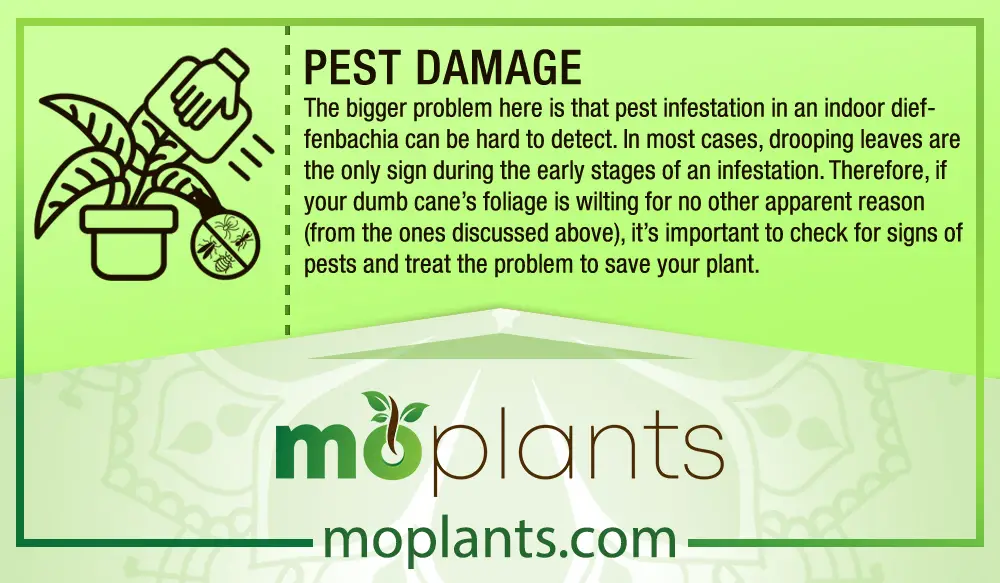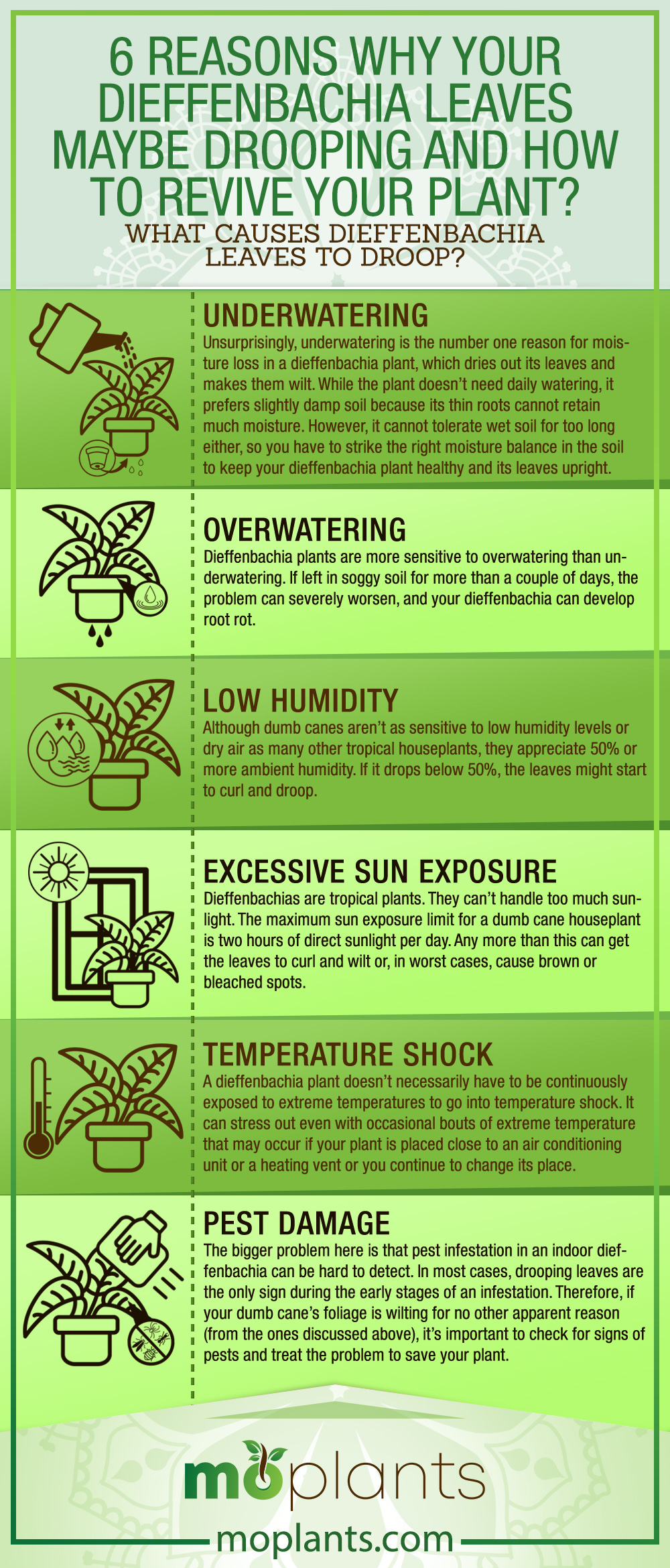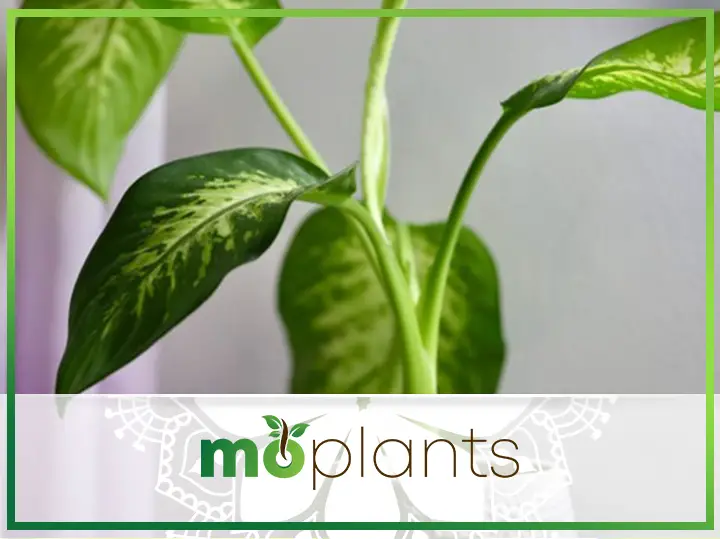Dieffenbachia, also called dumb cane, is a popular houseplant characterized by its big, showy green leaves with creamy white blotches. In all its glory, dieffenbachia looks spectacular with its thick, shiny leaves that can grow up to a foot long.
However, when not well taken care of, dieffenbachia leaves start to droop, making the plant look miserable, and growers wonder what caused the problem. If your dieffenbachia is also losing its lush appearance and converting into a sad-looking wilting plant, this article will help you figure out the reason behind it and will also provide tips on how you can help your plant regain its lost glory and stand tall once again.
What Causes Dieffenbachia Leaves to Droop?
There can be several reasons for the gorgeous dieffenbachia leaves to droop, but most of them come down to the water. Moisture loss or dehydration is the primary cause of droopy dieffenbachia leaves, which can happen for several reasons. Let’s look at them all and also discuss some other factors that can cause your dieffenbachia foliage to slump.
The possible reasons why your dieffenbachia plant leaves may be drooping include:
Underwatering
Unsurprisingly, underwatering is the number one reason for moisture loss in a dieffenbachia plant, which dries out its leaves and makes them wilt. While the plant doesn’t need daily watering, it prefers slightly damp soil because its thin roots cannot retain much moisture. However, it cannot tolerate wet soil for too long either, so you have to strike the right moisture balance in the soil to keep your dieffenbachia plant healthy and its leaves upright.
Like any other plant, there isn’t any fixed watering schedule for dieffenbachia plants. For some people, watering once a week works just right, while for others watering once every two weeks is the right frequency. You have to figure out the right time to water your plant on your own, but we have a useful tip for you.
The best way to know if it’s time to water your dieffenbachia plant or not is to check its soil. The top 1 to 2 inches (2 to 5 cm) of soil must be before you water your dumb cane. If it isn’t, it’s not yet time to water your plant.
How to Know If Your Dieffenbachia Is Underwatered?
Check the soil. If it’s excessively dried and hardened up, you can be pretty much sure that your dieffenbachia is underwatered and dehydrated. Soil peeling back on the sides of the container is another sign of dehydrated dieffenbachia.
Although this is the most obvious sign of an underwatered dieffenbachia, yours does not necessarily have to be so excessively dehydrated to exhibit drooping leaves. Another way to figure out if you have not been watering your dieffenbachia plant enough is to insert a thin wooden stick into the soil down to the bottom of the pot. Take it out after a couple of minutes. If it’s completely dry, your plant is underwatered.
How to Fix Underwatered Drooping Dieffenbachia?
Good news! More often than not, an underwatered drooping dieffenbachia can be revived easily and quickly.
All you have to do is to give the plant soil a good soak. Water the plant until it starts trickling out from the hole in the pot. Your plant will most likely be upright again within a couple of hours.

Overwatering
For those new to planting or gardening, it may be surprising to know that overwatering can dehydrate the leaves of dieffenbachia and cause them to wilt.
Wondering how on earth that is possible? Here’s how:
We all know that the leaves of a plant rely on the roots for their supply of water. And roots require oxygen to do their work. Under normal circumstances, the roots get the oxygen they need from air pockets in the soil. But when you water the plant more than it needs, those air pockets in the soil get filled with water. As a result, the roots cannot get enough oxygen and fail to do their job, causing the leaves to dehydrate and droop.
Dieffenbachia plants are more sensitive to overwatering than underwatering. If left in soggy soil for more than a couple of days, the problem can severely worsen, and your dieffenbachia can develop root rot.
How to Know If Your Dieffenbachia Is Overwatered?
If your dieffenbachia plant has droopy leaves and looks underwatered and dehydrated even when the soil is damp, it’s clearly overwatered. You could also use the wooden skewer technique described in the previous section. If your plant is overwatered, it will come out wet or soaked through.
If there is a musty odor coming from your dieffenbachia, it has developed mushy stems, or you can spot fungus gnats on it, it has likely developed root rot.
How to Fix an overwatered Drooping Dieffenbachia?
If it’s just a case of overwatering, you can restore it just by letting the soil dry out. However, if your plant has developed root rot, you must uproot it, trim the affected roots, and then repot it in fresh soil.
Roots that have developed the rot usually appear brown, gray, or black. They may also feel slimy and/or mushy.

Low Humidity
Although dumb canes aren’t as sensitive to low humidity levels or dry air as many other tropical houseplants, they appreciate 50% or more ambient humidity. If it drops below 50%, the leaves might start to curl and droop.
How to Know If Your Dieffenbachia Leaves Are Drooping Due to Low Humidity?
If you have been using artificial heating in your home (as most people do in the winter), low humidity is likely to be the cause of drooping leaves of your dieffenbachia plant as heating dries out the indoor air. However, the best way to determine (and ensure) if low humidity is causing your dumb cane leaves to wilt is to use a hygrometer.
How to Fix a Wilting Dieffenbachia with Low Humidity?
The answer to this lies in the question itself. You can fix the issues caused by low humidity by increasing the humidity in your dieffenbachia’s surroundings. Here are a few ways to do that:
- Shift your dieffenbachia to the kitchen or a bathroom. These places typically have higher humidity levels than other areas of the home.
- Use a humidifier to improve the moisture levels in the plant’s environment.
- If you have other tropical houseplants, placing your dieffenbachia near them could also help.
- Fill a shallow, flat-bottomed dish with gravel and add a little amount of water to it. Make sure to only add enough water that it doesn’t come to the top of the pebbles. Place your dieffenbachia over this DIY humidity tray.

Excessive Sun Exposure
Dieffenbachias are tropical plants. They can’t handle too much sunlight. The maximum sun exposure limit for a dumb cane houseplant is two hours of direct sunlight per day. Any more than this can get the leaves to curl and wilt or, in worst cases, cause brown or bleached spots.
How to Know If Too Much Sunlight is the Cause of Your Dieffenbachia Leaves Drooping?
If your dumb cane plant is placed too close to a window, particularly the one facing south or west, and has curled up or sagging leaves, it’s getting too much sun.
Brown or bleached spots on the leaves are also a sign that your dieffenbachia plant is getting too much sunlight. These spots are the sign of sunburn and signify dead cells.
How to Fix Excessive Sun Exposure Damage to Your Dieffenbachia Plant?
Move it a little away from the window – 4 to 6 feet is the ideal distance – or relocate it to a window on the north or east side. It should revive in a little while. However, if the leaves have developed brown or bleached spots, you will have to prune the plant to get rid of them; they won’t go away on their own.
One mistake many people make when dealing with a sun-damaged dieffenbachia plant is that they relocate it to a place that gets little to no light. Don’t do that. Dieffenbachias like bright light; they just don’t want it to hit their foliage directly. They grow best in a place where they get an adequate amount of indirect sunlight.

Temperature Shock
Has your dumb cane plant been exposed to excessive heat or cold? If yes, it may be in temperature shock, and that is what caused its leaves to wilt.
A dieffenbachia plant doesn’t necessarily have to be continuously exposed to extreme temperatures to go into temperature shock. It can stress out even with occasional bouts of extreme temperature that may occur if your plant is placed close to an air conditioning unit or a heating vent or you continue to change its place.
60 to 90 degrees Fahrenheit is the safe temperature range for dumb cane plants. Anything above or below can cause the leaves to droop or, worst, discolor.
If your dieffenbachia seems to be in temperature shock, relocate it to a place where it gets the required temperature. If the damage is not too severe (or the plant hasn’t already died), your dieffenbachia will revive on its own.

Pest Damage
Like many other plants, dieffenbachias can develop pest issues. These bugs feed off the nutrient-rich plant sap, causing the plant to wilt and eventually die.
The bigger problem here is that pest infestation in an indoor dieffenbachia can be hard to detect. In most cases, drooping leaves are the only sign during the early stages of an infestation. Therefore, if your dumb cane’s foliage is wilting for no other apparent reason (from the ones discussed above), it’s important to check for signs of pests and treat the problem to save your plant.
Common dieffenbachia pests include:
Mealybugs – They produce a fuzzy, pale wax-like substance and coat themselves in it, which makes them appear like tiny strands of cotton. These bugs hide in the crevices within stems and leaves.
Scale Insects – These produce dark brown-colored sticky residue and appear as natural growth on the trunk of your dumb cane plant.
Aphids – Aphids are pear-shaped insects that are usually bright green in color, but they can also be orange, brown, red, gray, and black. These pests can be found in clusters near the freshest growths on your dieffenbachia. They also produce sticky residue and white exoskeletons.
Spider Mites – These are the most common pests on dieffenbachia plants. But they are also the hardest to detect. You can only see spider mites with a magnifying glass. The only way to figure out if your dumb cane plant has got a spider mites infestation is to look for pale dots on the surface of its leaves. A severe spider mites infestation will cause thin cobwebs all around your dieffenbachia foliage.
If you suspect a pest infestation, inspect the stems and leaves of your dumb cane plant closely and carefully to confirm.
How to Deal with a Pest Infestation in Dieffenbachia Plants?
If your dieffenbachia has developed a pest problem, follow these steps to resolve it:
- Rinse the plant, preferably using a strong stream of water.
- Wipe down the whole plant, including the trunk, stem, stalks, and leaves, with cotton soaked in rubbing alcohol.
- Spray the plant with a pesticide. You can also make your own pesticide by adding a teaspoon of neem oil and 1/3rd teaspoon of mild liquid soap into one liter of warm water. Shake the mixture well and spray it on your affected plant.
Repeat this process every few days until the pests are completely gone, and your dieffenbachia is healthy again.

Infographic

Wrap Up
Dieffenbachia plants are quick to show signs of distress. Multiple factors can cause their leaves to curl and droop. You need to look for the signs and carefully evaluate your care routine and growing conditions of the plant to figure out what could be causing it to lose its vigor and wilt. Once you find the underlying reason, half the battle is won. Fixing most issues is easy.

